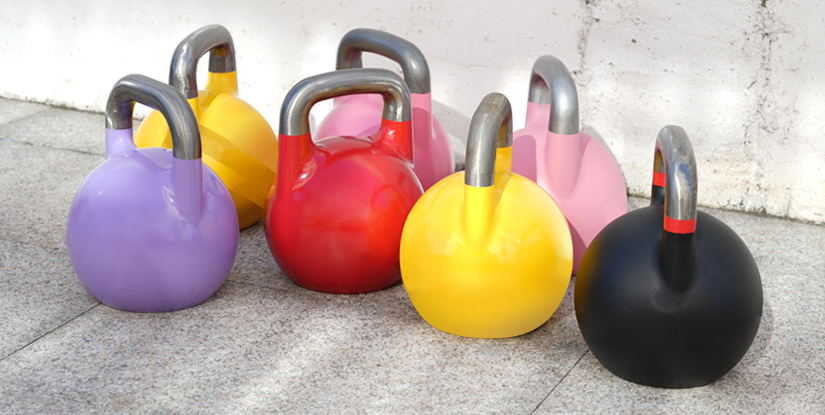When I first started looking into kettlebells more seriously — especially for commercial gym use — I kept running into one big question: cast iron vs steel kettlebells. I’d seen both terms thrown around, but honestly, I wasn’t sure why it mattered.
Was it just a material thing? A durability thing? Or maybe just branding?
The deeper I dug, the more I realized there’s a real difference — and it actually matters, especially when you’re buying for a gym where dozens of people will use the equipment every day.
So I pulled together everything I found and put it into this article — what makes cast iron and steel kettlebells different, who each one is best for, and what you should look out for when you’re buying for a gym.
What’s the Actual Difference Between Cast Iron and Steel Kettlebells?
Once I started comparing models side by side, the difference between cast iron and steel kettlebells was way more obvious than I expected.
Steel kettlebells are almost always competition-style — meaning no matter the weight, the bell is the exact same size. An 8kg steel bell is the same height, width, and handle spacing as a 32kg. That’s not just a design choice — it’s a performance thing. Technique stays consistent no matter what you’re lifting.
Cast iron kettlebells, on the other hand, grow in size as the weight goes up. So a 12kg bell might feel totally different in your hands than a 28kg one — even if your form is spot-on. For general training, maybe that’s fine. But in a commercial gym where lifters are cycling through different weights every session, that can throw things off.
Besides the material and shape, there are also differences in handle feel. Cast iron bells often have thicker or wider handles — and they’re not always uniform across brands. Steel comp bells usually follow tighter specs, which makes programming more reliable when you’re training clients or members at scale.
Here’s cast iron vs steel kettlebells:
| Feature | Cast Iron Kettlebell | Steel (Competition) Kettlebell |
|---|---|---|
| Material | Solid cast iron | Hollow steel shell |
| Size | Increases with weight | Uniform size for all weights |
| Handle Shape | Often thicker and varies between models | Standardized across all weights |
| Feel During Use | Changes as weight increases | Stays consistent across weight jumps |
| Best For | Basic lifting and general use | High-volume, technique-focused training |
Why Competition Bells Are Always Steel — And Why That Matters for Commercial Gyms
When I dug into competition kettlebells, one thing stood out: they’re always made from steel. That’s not some random choice — it’s actually a Girevoy Sport standard. The whole point is to keep the dimensions exactly the same no matter the weight.
Why’s that so important? Well, it means your cleans, racks, and snatches feel consistent every time, whether you’re swinging 8kg or 32kg. For commercial gyms running classes or coaching multiple clients, that kind of consistency is gold. It helps lifters nail technique and safely progress through heavier weights without awkward surprises.
Once I got that, it totally clicked why serious lifters swear by steel comp bells — it’s about performance and reliability, not just looks.
On top of that, steel kettlebells are built to take a beating. In a commercial gym setting, where these bells get tossed around daily, durability is everything. Plus, for instructors coaching classes, having a set of bells that all feel the same in your hands makes it way easier to cue proper form and give clear advice.
So, who should go for steel comp bells? My take is simple:
- If you want serious progress and solid technique,
- If you run classes or train multiple clients,
- If you’re lookin’ for gear that actually holds up to heavy use,
Steel comp bells are the way to go. Honestly, my gym only buys comp-style kettlebells now — no regrets at all.

Cast Iron Kettlebells: Old-School and Still Useful
Cast iron kettlebells sometimes get a bad rap, but honestly, they’re still pretty solid for general training. Especially if you’re working with a commercial gym setup and want to offer some variety without breaking the bank.
Here’s the deal with cast iron bells:
Pros:
- Usually cheaper, which is nice when you’re stocking up a gym.
- Perfect for stuff like swings, Turkish get-ups, and presses — the basics that most people need.
Cons:
- The handle shapes can be all over the place, which means grip and feel aren’t always consistent.
- As the weight goes up, so does the size of the bell itself — and that can mess with your technique when moving between weights. Big bells mean big bodies, and that doesn’t always translate well when you jump back to smaller sizes.
Who Should Use What? (My Take)
So, who’s cast iron actually good for? I’d say:
- Beginners or gyms with more casual training sessions.
- Great if you’re focusing on strongman-style swings or low-rep, heavy lifts.
While I’m all about steel comp bells for serious commercial gym use, cast iron still has its place — especially when cost or variety matters.
Honestly, don’t stress too much if your first kettlebell is cast iron — it’s not a bad start. But if you’re running or outfitting a commercial gym and want consistent training results, steel competition kettlebells are definitely the way to go. They just make everything smoother, from coaching to technique progression.

Hi, I’m the editor here at Leadman Fitness. We’re a manufacturer focused on producing top-quality barbells, plates, kettlebells, dumbbells, and strength training gear. I’ve been into sports and fitness for years, and I know my way around all kinds of gym equipment—both from using it and helping create it.
I spend a lot of time understanding the real problems people run into in the gym—whether it’s beginners trying to pick the right gear or experienced lifters looking for something more durable. I stay in close touch with our production team and talk directly with other equipment makers, so we’re always improving based on what real lifters and coaches are looking for.
What I share comes from hands-on experience—stuff that actually helps people train better, not just in theory, but in real gyms.
